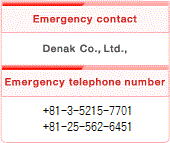Monochloroacetic acid, 80% aqueous solution(Detailed information)
1.Product and Company Identification
| Product Name | Monochloroacetic acid, 80% aqueous solution |
|---|---|
| Company name | Denak Co.,Ltd. |
| Address | Kudan First Place, 4-1-28 Kudan Kita, Chiyoda-ku, Tokyo, 102-0073 Japan |
| Person in Charge | Marketing Manager |
| Telephone No. | +81-3-5215-7701 (main) |
| Fax No. | +81-3-5215-7705 |
| Emergency contact | Denak Co., Ltd., |
| Emergency telephone number | +81-3-5215-7701 |
| MSDS No. | 001 |
2.Composition/information on ingredients
| Substance/preparation | Mixture |
|---|---|
| Chemical name | Monochloroacetic acid |
| Synonym | Chloroacetic acid |
| Ingredients and contents | Monochloroacetic acid (≥80%) and water (≤20%) |
| Chemical properties | CH2ClCOOH、Molecular weight: 94.50 |
| Reference Number in Gazetted List in Japan | (2)-1145 |
| CAS No. | |
| Hazardous ingredients | Monochloroacetic acid |
| Hazardous impurities | Not Applicable |
3.First aid
Provide the material safety data sheet of this product to the physician when receiving treatment at a hospital. (*Note 1 below.)
If the patient might have touched or ingested monochloroacetic acid or might have been exposed to its vapor, or if symptoms indicative of such events appear, be sure to have the patient seek medical care from a physician. Since the effects of exposure can be delayed, medical follow-up is [always] necessary.
1Note: Click here to download the data sheet →Monochloroacetic acid, 80% aqueous solution(synonym: Chloroacetic acid)PDF[368KB]
Inhalation:
- Wrap a blanket around the patient, allow the patient to rest quietly, and immediately move him/her to a place with fresh air.
- Immediately transport the patient to a hospital.
- If the patient has dyspnea or has stopped breathing, immediately begin artificial respiration or use a resuscitator.
Skin contact:
- If monochloroacetic acid comes into contact with the skin, it is most important to immediately immerse the skin in sodium bicarbonate solution or immediately wash with large amounts of water.
- If an extensive area is affected, immerse in a bath of approximately 3-5% sodium bicarbonate solution (water temperature: 25-35℃) for a minimum of 4 hours, and seek medical care from a physician.
- Contaminated clothes should be removed promptly as the aforementioned treatment is performed.
Eye contact:
- Since this substance can injure the cornea and the eyelids, immediately wash the eyes for at least 15 minutes with large amounts of 0.9% saline solution or purified water. Be sure to seek medical care from an ophthalmologist.
- Washing of eyes can be achieved effectively by opening the eyelids with the thumb and index finger.
- If the patient is wearing contact lenses, unless they are adhered, take them off and wash the eyes.
Ingestion:
- Rinse the mouth well and have the patient drink water. (Do not induce vomiting.)
- Allow the patient to rest quietly and to breathe fresh air. Place the patient in a reclined position and transport the patient to the hospital.
Most important signs and symptoms:
Pain on the skin, burning pain, severe chemical injury, cold sweat, nausea, edema, dyspnea, blood pressure decline, coma, shock, pain and swelling of the eyes, and pain and tightness of the respiratory tract and lungs
Protection for people providing emergency measures
In rescuing the victim, wear acid-resistant clothes, long boots, and goggles or full face shield, latex or polyvinyl chloride gloves.
Special precautions for physicians:
Monochloroacetic acid penetrates the skin and reacts with components of the blood and cells. It immediately forms sodium monochloroacetate and travels to other tissues including the brain via the blood (leading to destruction of cells). In addition, monochloroacetate compounds are formed from the interactions between highly concentrated MCA and blood and between highly concentrated MCA and cellular components. These compounds can cause serious symptoms, and prompt treatment is necessary. If monochloroacetic acid comes into contact with the skin, it is most important to immediately immerse the skin in sodium bicarbonate solution or immediately wash with large amounts of water. If possible, immerse in a bath of approximately 3-5% sodium bicarbonate solution (25-35℃) for a minimum of 4 hours (until the white patch produced from the chemical injury disappears). If the extent of chemical injury is 1% or more of the total body surface area, it can become a serious injury. Therefore, the symptoms should be continuously monitored in a hospital for at least 24 hours. Vomiting and decrease in blood pressure are signs of worsening symptoms. Flamazine ointment or Hirudoid ointment should be used as medication for the skin. Treatment should include blood pressure measurement, measurement of monochloroacetic acid content in blood, artificial respiration, resuscitation, N-acetyl cysteine therapy (detoxification treatment), hemodialysis, plasma exchange, and alkalinization.



